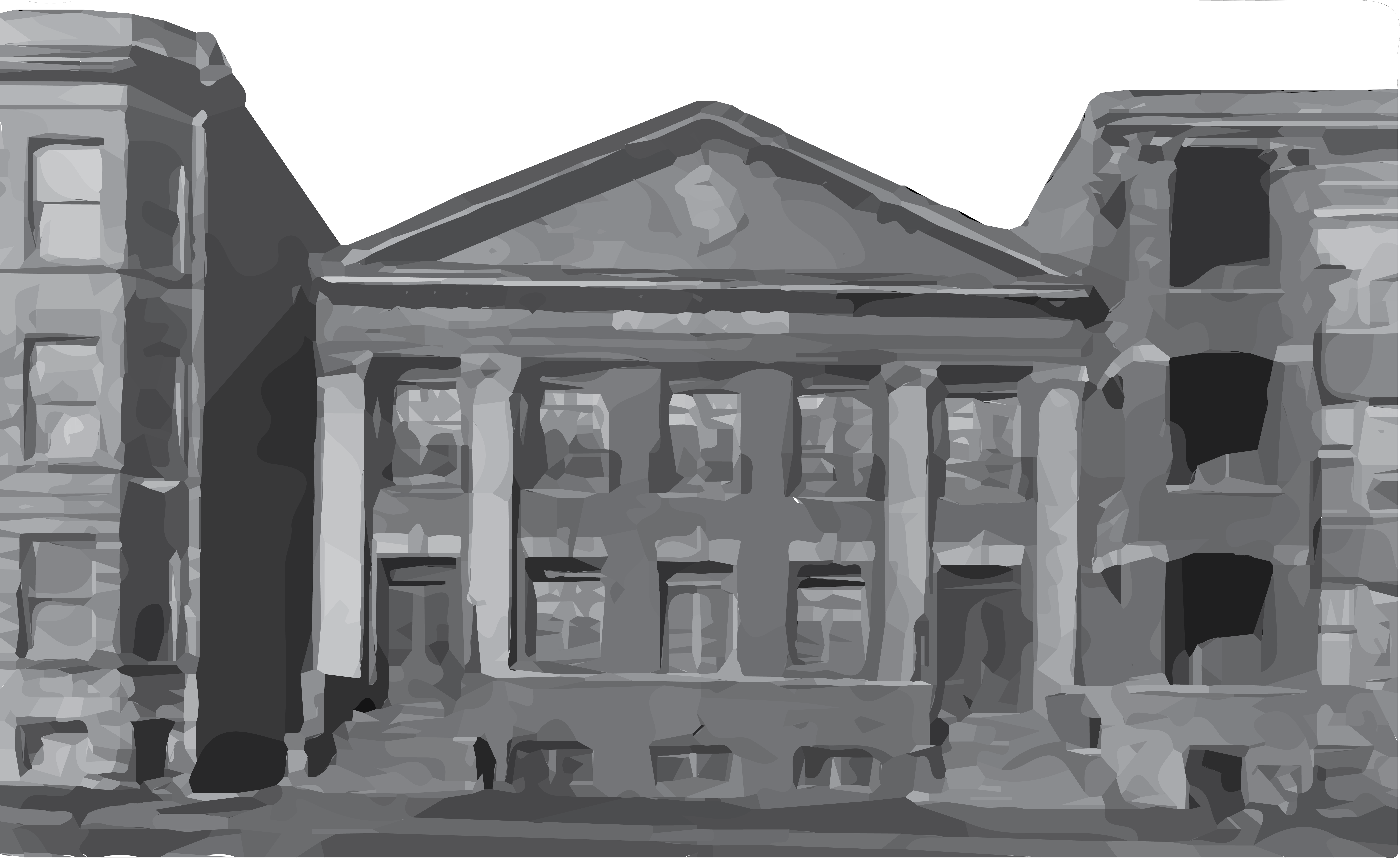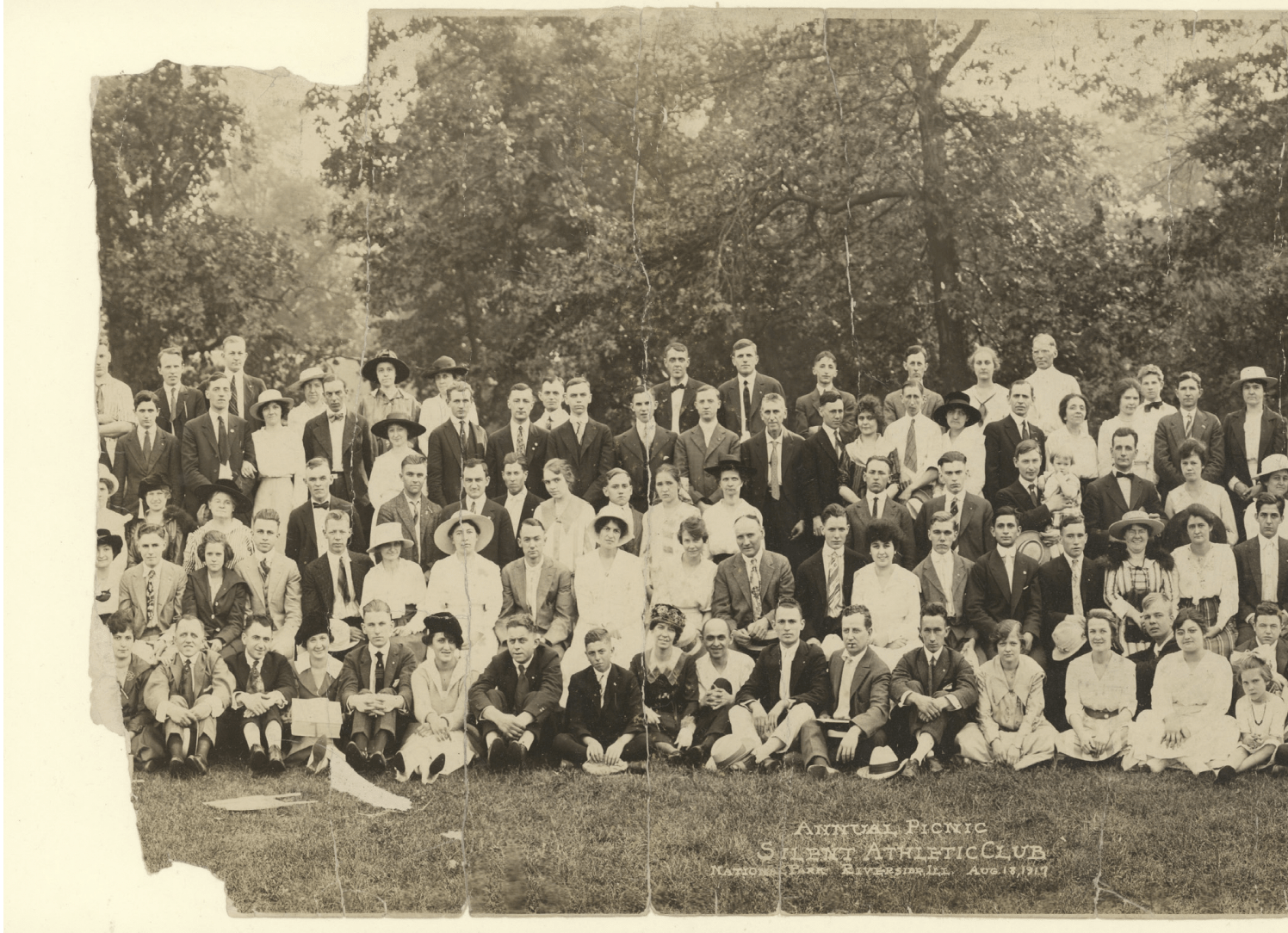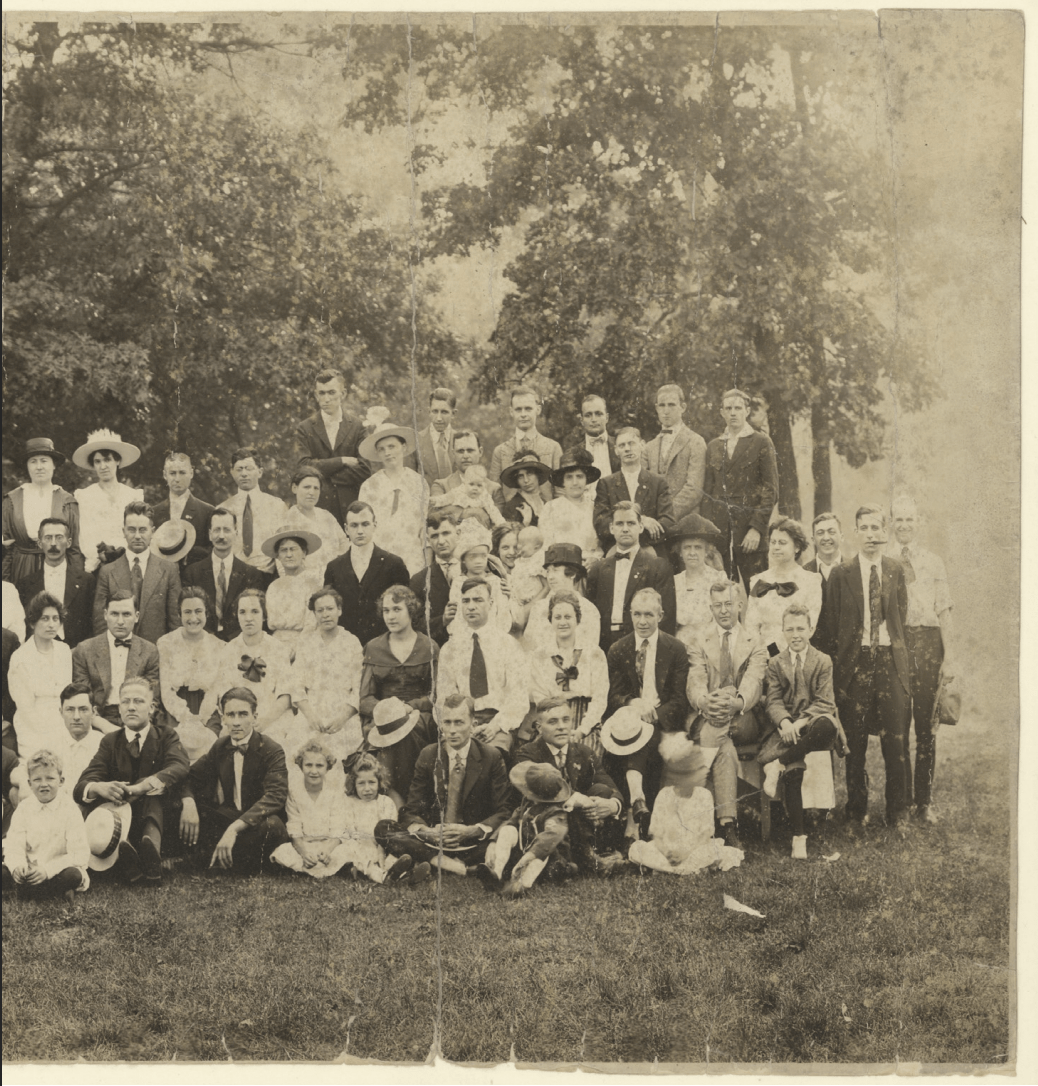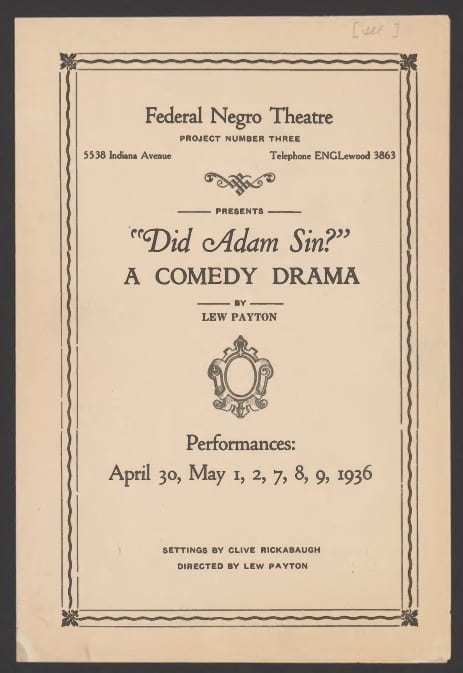The Ladies Auxiliary of the Ridgeway Club Adopts Fantastic Costume and Burnt Cork in Performance—Catchy Songs Applauded.1
The Silent Athletic Club in The Silent Worker vol. 31 no. 8 (digitally altered). Courtesy of Gallaudet University
Frank H. Graham was a prominent Chicago lawyer and municipal court judge. Fredrick N. Matthews was a respected businessman and fur trader. Frank E. Lukens was the former clerk of Peoria, secretary of the Milwaukee wholesale coal dealers association, and secretary of the Retail Dealers’ Association of Illinois and Wisconsin. Many of these men and their families were originally from other areas of Chicago and the Midwest and convened around Garfield Boulevard in the beginning of the 20th century as the area quickly grew due to investment following the World’s Fair of 1893. As wealthy and powerful individuals began to congregate in the space, the Ridgeway Club grew to be one of the most prominent clubs in Chicago according to Rand McNally. However, in just ten years, this club was disbanded, and all news and information of its happenings disappeared like dust. The club left with haste and sold the building—which was valued at around $50,000—for the mere price of $25,000.2
At around the same time, a community of an entirely different character was taking shape along Garfield Boulevard. It was a hamlet of the Deaf, a growing group of intellectuals, leaders, and socialites fighting for expanded representation and support for their community. This started through sporting clubs like baseball and basketball teams. These “Silent Athletic Clubs” would hold matches against other teams in their respective cities. As a group that was typically associated with homelessness, begging, and mental incapacity, these athletic clubs were a public display of the Deaf community’s true identity. As this community expanded, the Silent Athletic Club of Chicago decided to further display the true extent of Deaf organizing power and strength by purchasing the beautiful Ridgeway Club, a building which had already gained prominence on the South Side, by using only Deaf funds.
The athletic club undertook the responsibilities of a social club, acting as a site where the Deaf of Chicago could recreate, socialize, and hold events. This new clubhouse was described by The Silent Worker as “The Most Superb Silent Clubhouse” and the place “Where Dreams Come True.” The clubhouse’s glamor became a symbol that the Deaf were a far more sophisticated community than the world believed it to be. The space was adorned with pool tables, bowling alleys, dressing rooms, luxurious leather chairs, desks, bookcases, reading and writing tables, and a parlor furnished in baronial oak. Featuring high ceilings and excellent ventilation, the main ballroom served as the community’s stage for dancing and theatrical performances.
The clubhouse became a central location for Southsiders both deaf and hearing. The Silent Athletic Club continually hosted their own balls while also renting out the space to other South Side organizations. Weddings, political meetings, and gatherings of widows all occurred at the SAC’s clubhouse. Just a few years after the Ridgeway Club left, the Deaf became the center of society in this little pocket of the South Side. However, like the Ridgeway Club before it, the Silent Athletic Club’s stay at the clubhouse was all too short: it lasted only until 1930, when the club decided to move to the North Side, citing Garfield Boulevard’s growing disrepute as a consequence of the expanding the Black Belt.3 Also like the Ridgeway Club, this group almost entirely vanished from the public eye after leaving 5536 S Indiana Ave, leaving only the clubhouse as a memory of their past prominence.
The clubhouse was promptly inhabited by an entirely different group shortly after the SAC’s departure from the neighborhood. The space, with its stage, waxed ballroom floor, and high ceilings, seemed too important to go to waste. The building was eventually renamed Igoe Hall, though the reason for this change is unknown. The operations of the clubhouse remained very similar to that of the Ridgeway and Silent Athletic Club, once again hosting a community searching for a space of their own.
For the first time, the clubhouse was inhabited primarily by Black social groups and clubs, reflecting the expansion of Chicago’s growing Black community on the South Side. The clubhouse hosted groups of all kinds, from the Fifth Ward Women’s organization4 to the American Legion5, from Howard University Alumni6 to local bowling leagues7. Esteemed sociology professor Louis Wirth of the University of Chicago even hosted a seminar in the clubhouse for students and neighborhood members titled “Illusions of Racial Supremacy.” No matter what people or activities it hosted, the clubhouse continued to serve as a connection point for the community. However, like the tenants that preceded it, Igoe Hall fell victim to the changing nature of Washington Park. Its tenure in the clubhouse only lasted around five years, once again leaving the door open for the next community.
The next community to inhabit the clubhouse would lean on the space as a shelter for its artform: Theatre, a particularly vulnerable art during the Great Depression. The art form’s prominence had quickly plummeted during the Great Depression, which not only weakened this important cultural activity, but also left artists, writers, directors, and theater workers out of jobs. The Works Progress Administration created the Federal Theatre Project (FTP) in response to this issue, establishing a federation of regional theaters around the country that were to create relevant art. These spaces would allow artists to experiment and encourage the American public to experience live theater. One of these regional theatres became home to Chicago’s Negro Division of the FTP. The group had previously staged performances in parks, hospitals, and schools but eventually found a permanent home at 5536 S Indiana Ave, a relatively modest performance venue, yet ample space for the division’s purposes. One of the company’s first presentations was titled Romey and Julie, an adaptation of Shakespeare’s tragedy Romeo and Juliet. Set in Harlem, the play dramatized the tragic love story of Romey, an African American, and Julie, an Afro-Caribbean immigrant. Their second production was titled Did Adam Sin? and it dramatized the story of a Black family in Harlem trying to survive the Great Depression.8
Silent Athletic Club Annual Picnic at National Park Riverside, Illinois, (1917). Courtesy of Gallaudet University
Did Adam Sin? Playbill. Courtesy of the Library of Congress
Once a clubhouse for the South Side elite, within the span of 30 years the old Ridgeway Club had become a center of innovation and stage for Black arts and culture. This clubhouse and the neighborhood around it changed at unprecedented speed and in the most unexpected ways. On the very same stage where the Ridgeway Club’s women’s auxiliary presented racist comedy in blackface, the FTP’s Negro Division presented the realistic experience of a Black person in America during the Depression. Under the FTP’s ownership, the space was renamed the Palais Des Gardes, and along with theatrical productions, the space continued to host events for the many clubs and societies of Chicago’s South Side. By the 1940s, the FTP needed a larger and more central location in Chicago, and decided to move their operations out of the neighborhood to the Princess Theatre downtown.9
By the 1960s, Washington Park had been transformed by disinvestment, segregation, and an aging housing stock that destroyed the neighborhood’s built environment. At this time, 85% of the housing in the neighborhood had been built before 1940, and almost half of the structures were deemed to be in “substandard condition.”10 Population levels had dipped below what they were in 1930, and the neighborhood had become 99% Black.11 Physically, the environment was becoming more barren as apartment fires, defective plumbing, broken plaster, faulty wiring, and overcrowding forced tenants to abandon their homes. The neighborhood, which had already been vulnerable to turnover, was losing its very structure. Its main thoroughfare, Garfield Boulevard, and spaces like 5536 S Indiana Ave had historically served as places where vulnerability could, even if it was just for a short time, become stability, but as the neighborhood’s built environment slowly crumbled, so did the feasibility of spaces for cultural incubation. For a neighborhood that had changed and rebuilt itself multiple times within just a few decades, spaces like 5536 S Indiana Ave had become necessary for the cultivation of community and shared identity.
Child by Child we build our nation” is not an inscription from a historic site, but the motto of more than 5,000 south siders—some now grownups—who since 1945 have practiced how to play and pray together in an old red brick building at 5536 Indiana Ave.
5536 S Indiana Ave’s final tenant was an organization built in response to Washington Park’s deteriorating conditions, and one that was able to enrich the community despite adverse circumstances. In 1945, led by local religious and civic leader Bishop Marzella Hall, the space was converted into a community center and church. The community center, officially called the Marzella Hall Community Youth Center, was an organization that worked to embolden the lives of young children through meaningful and enriching activities. Bishop Hall, a leader with an incredible passion for the nation’s youth, along with volunteers from the neighborhood, administered programming after school hours and worked to educate children in music, arts, and civic engagement. The students presented musicals for the community and performed as a choir in the Bud Billiken Parade. “Child by Child we build our nation” was the program’s motto.
Apart from the programming of Marzella Hall’s youth center, she also served as the minister of a congregation based out of 5536 S Indiana Ave called the Holiness Community Temple, one of the most prominent religious organizations on the South Side. At a time when government and private investments in Washington Park were the lowest they had been in many years, these churches worked as the primary administrators of public-facing activities and civic engagement. The church allowed mayoral and aldermanic candidates to workshop their campaigns with local residents, organized protests against racial discrimination in the workforce, and ran food drives for neighbors in need of reliable food options. Beyond civic engagement, the Holiness Community Temple also served as an incubator for the arts, culture, and neighborhood pride. An annual Mother’s Day concert became a starting point for some of Chicago’s emerging artists, the most notable being Sam Cooke, whose career is rumored to have launched at the Mother’s Day concert that took place during his senior year of high school. Holiness Community Temple also hosted birthday parties for the church’s leadership, and even for Chicago’s first Black mayor, Harold Washington, who blew out the candles for his 62nd birthday at the church.
After the death of Marzella Hall, the church leadership was handed over to former assistant pastor Reverend Zepheree Barnes and veteran South Side activist and politician Reverend Earle Sardon. Anything short of a book-length study is insufficient to fully articulate the achievements of these two community leaders, who both had immense influence. Rev. Barnes was one of the earliest major figures to support Mayor Harold Washington’s first mayoral bid in 1977. Rev. Sardon was the leader of the Negro Labor Relations League, an activist group aimed at protesting segregationist hiring practices in Chicago, as well as the Crusaders of Justice, a mutual support group with offices on Garfield Boulevard. Sardon was a colleague of Martin Luther King Jr.’s and one of the most important figures in Chicago’s civil rights movement. The leadership of the Holiness Community Temple was a telling indicator of the congregation’s position in the Washington Park community. The church was so much more than a place of prayer. In the truest sense, it was a Community Temple.
After Reverend Barnes’ death in 1988, Reverend Earle Sardon became the sole leader of the congregation. However, with Sardon’s old age and a neighborhood population decrease of over 50% through the 1980s, the prominence of the Holiness Community Temple was almost entirely lost, with only small remnants of the congregation’s once large following left behind. Even the congregation’s largest asset, the clubhouse, was eventually abandoned as the congregation moved to a smaller space on 61st Street. After the clubhouse’s final tenants left the building, it lay uninhabited for several years. In 1998, the building was demolished for good.

Official Program for the 1945 National Clubs of the Deaf Basketball Tournament (digitally altered)
The long and varied history of the area we now call Washington Park was manifested on the stage of this red brick building. The performers, speakers, preachers, musicians, and common people who took this stage represent Washington Park’s everchanging character. The building itself never really had a name and never really built an identity, as evidenced by the many fleeting communities who have called the space home. The building, which is now simply a grassy field, has almost completely been lost in history, along with the stories that echoed through its walls. A single Washington Park never really existed. And neither did a singular Ridgeway Club, or whatever you might choose to call the red brick building that once stood at 5536 S Indiana Ave. Both the neighborhood and the clubhouse were liminal spaces that were written over by the chapters of Chicago’s history. It was a place that people were both pushed into and out of, yet it was always a space that embraced and emboldened its inhabitants.
Now a grassy field, 5536 S Indiana Ave is a poorly written elegy to the many exuberant and diverse Washington Parks that once existed. The destruction of the building was not only an erasure of the site’s history, but also a loss of an important meeting space for the members of Washington Park, whoever they may have been or might be. Though the building would have been a valuable resource for the current Washington Park, or the next Washington Park to come, the least we can do is remember the site’s history and its everlasting impact across many histories, communities, and identities.
A single Washington Park never really existed. But the Ridgeway Club did, and so did the Silent Athletic Club, and so did the Holiness Community Temple; these institutions are the cornerstones and the very identity of this odd space between neighborhoods we now call Washington Park. To truly understand Garfield Boulevard, its people, and its history, we must also understand the crucial role of the communities who have kept Washington Park together.
Footnotes
- “Women Minstrels Score Hit in Show.”
- Meagher, “Where Dreams Come True.”“Kelly Miller Was ‘Tricked,’ Says Howard Alumni Head”
- “Chicago.”
- “Among the City Clubs.”
- “Installs Officers.”
- “Kelly Miller Was ‘Tricked,’ Says Howard Alumni Head.”
- “Bowling.”
- Vactor, “A History of The Chicago Federal Theatre Project Negro Unit: 1935-1939.”
- Vactor.
- Kitagawa and Taeuber, Local Community Fact Book.
- Kitagawa and Taeuber.
Bibliography
“Chicago” Vol. 59 No.48 (November 27, 1930). http://archive.org/ details/gu_deafmutesjo19301127.
Kitagawa, Evelyn M., and Karl E. Taeuber. Local Community Fact Book: Chicago Metropolitan Area, 1960. Chicago, IL: Chicago Community Inventory, University of Chicago, 1963. https://catalog.lib.uchicago. edu/vufind/Record/81940.
Meagher, Frederick J. “Where Dreams Come True.” The Silent Worker, Vol. 31 No. 8 edition. Accessed October 16, 2023. https:// gaislandora.wrlc.org/islandora/object/gaislandora%3A4150#page/1/ mode/1up.
The Chicago Defender (National Edition). “Among the City Clubs.” March 30, 1935.
The Chicago Defender (National Edition). “Bowling.” March 30, 1935.
The Chicago Defender (National Edition). “Installs Officers.” October 22, 1932.
The Chicago Defender (National Edition). “Kelly Miller Was ‘Tricked,’ Says Howard Alumni Head.” November 10, 1934.
The Inter Ocean. “Women Minstrels Score Hit in Show.” n.d. https:// www.newspapers.com/image/34590431/.
Vactor, Vanita marian. “A History of The Chicago Federal Theatre Project Negro Unit: 1935-1939,” 1998.



